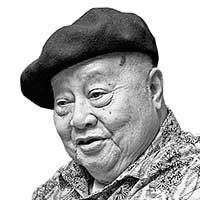A memoir of Tokyo in the fifties

My real consciousness of Japan started in December 1941 when Japan attacked Pearl Harbor. That consciousness turned to loathing in the three years that we were brutalized during the Japanese Occupation.
I went to Japan for the first time in 1955, and that loathing turned to apprehension. Having survived the Japanese Occupation I knew not just hunger but fear. I thought I would never establish social relations with the Japanese, but I did, with several young people who were introduced to me by a Filipina student in Tokyo.
The airport in Manila was a shed in Nichols Field, the plane a double-decked Boeing Strato cruiser. In those days, air travellers were well dressed and I was wearing my first suit tailored in Escolta. The plane took off early in the evening and it was daybreak when we reached Japan, my first view of that country the majestic Fuji capped with snow.
The airport in Haneda was a nondescript building surrounded by mud flats. I was billetted at a small hotel in Nihonbashi called Yashima. One dollar was equivalent to two pesos and was worth 340 yen – I was very rich on my first trip to Japan. The dollar today is about 100 yen.
All over Tokyo were the skeleton remains of buildings and smoke stacks of gutted factories. Streetcars clattered along the main streets and the Ginza, the main shopping street, was lined with willow trees, all the alleys that converged on it alive with small shops.
To discover the city, I took the subway; there was only one line then, the Ginza which started from Shibuya and ended in Asakusa. Tokyo was ringed by the Yamanote line and I remember that in some parts of the city there were still rice fields.
Tokyo’s department stores were shopping meccas. At the top floor were the bargain shops and it was also there where craftmen displayed their work and showed how they worked. One of my first visits was to a folk art museum where I saw the origin of Japanese craftmanship that was evident in the quality goods that they produced, contrary to the cheap Japanese exports that reached us before World War II.
In 1955 Japan was still poor. The woman who cleaned my room gathered the wrapping paper of the goods that I bought. All over the city, boys delivering soba rode on bicycles, balancing with one hand the tray with the noodles. It was masterful cycling and balance. I was introduced to buckwheat noodle which I liked immediately.
I went to Shibuya because I was told there was a restaurant there specializing in whale sushi. I remember the station’s wooden stairs swaying as one went up the platform.
I stopped at many stations and wandered around each neighborhood. Tokyo has always been a city made for walking, the streets full of surprises, temples, shops. Yoshiwara, the famous red light district had already closed but it was not difficult to find female company in the city’s many night clubs, the music in them provided by Filipino bands. The famous Nichegeki in the Ginza attracted audiences with its bare-breasted showgirls. Bimbo Danao from the Philippines sang at the theater, adored by scores of young Japanese. He told me of his wonderful life.
In the late evening, a flute would wail in the street and I would go down to the sidewalk where a man with a pushcart sold me a bowl of noodles with nameless greens. At the Nihombashi station, I would get another bowl of oden – hardboiled egg, fishballs, and kelp with hot mustard.
The scholar Edward Seidensticker invited me to lunch at the famous Imperial Hotel. Designed by Frank Lloyd Wright, it was an icon that disappointed me. It was dark, and with a very low ceiling, with no attributes from traditional Japanese architecture. I was shocked when the soup arrived – a bowl of tulya, the tiny clams that at the time only the poorest Filipinos ate.
I knew even then that Japan would eventually rise from the rubble of war. They were already manufacturing cameras that were exact imitations of German models. But above all, the infrastructure for industry was intact. Skyscrapers did not yet dominate Tokyo’s skyline. The tallest building, the Takashimaya Department Store in the Ginza, was a mere 12 storeys high.
I visited Kyoto, Japan’s ancient capital. There were no bullet trains then, and the trip by steam-engined train took almost the whole day, All the way to Kyoto, a manicured landscape, ricefields, orange trees and neat houses roofed with grass. I stayed at a Japanese inn, the Kanewaro Bekkan, which I revisited several times in succeeding trips. It is still there.
My room overlooked the Kamo River, alive with workmen washing long strips of cloth. One night, I took a tour of the geisha district, saw the Taiyu, a courtesan whose wooden shoes were so high she could stumble but she did not. I saw the finer aspects of the culture, the craftsmanship in pottery, weaving, paper products.
The farmhouse where I stayed was roofed with thatch, with the fireplace in the center of the house. My breakfast consisted of rice, soy bean soup and pickles.
What impressed me most on my first visit to Japan was the seeming purposeness of the people as they marched to work in the morning, the uniformity in their clothes, their exquisite manners and the superb quality of craftsmanship on display everywhere. Efficiency everywhere, too – in government and private offices, and wonder of wonders, the trains always ran on time.
The people were also very helpful, polite. It was so difficult for me to understand how the same people had been so barbaric in the Philippines. Nevertheless, that visit convinced me of how much we can learn from the Japanese. Above all, how to build a nation. I hope we will.
- Latest
- Trending



























